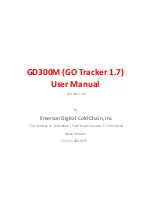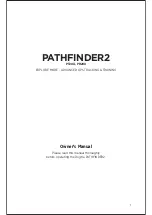
ODOMETER
: A running tally of the distance traveled for all trips.
This total does not clear when resetting the trip data.
OFF COURSE
: The distance to the left or right by which you
have strayed from the original path of travel. You must be
navigating for this data to appear.
OVER'L SPD
: The average speed for the current activity,
including both moving and stopped speeds.
SPEED
: The current rate of travel.
STOP TIME
: A running tally of the time spent not moving since
the last reset.
SUNRISE
: The time of sunrise based on your GPS position.
SUNSET
: The time of sunset based on your GPS position.
TEMPERATURE
: The temperature of the air. Your body
temperature affects the temperature sensor. Your device
must be connected to a tempe sensor for this data to appear.
TIME
: The time of day based on your current location and time
settings (format, time zone, daylight saving time).
TO COURSE
: The direction in which you must move to get back
on the route. You must be navigating for this data to appear.
TOTAL TIME
: A running tally of the total time spent moving and
not moving since the last reset.
TOT ASCENT
: The total elevation distance ascended during the
activity or since the last reset.
TOT DESCNT
: The total elevation distance descended during
the activity or since the last reset.
TRIP ODOM
: A running tally of the distance traveled since the
last reset.
TURN
: The angle of difference (in degrees) between the bearing
to your destination and your current course. L means turn
left. R means turn right. You must be navigating for this data
to appear.
VERT SPEED
: The rate of ascent or descent over time.
VMG
: The speed at which you are making progress into the
wind.
VSPD DEST
: The rate of ascent or descent to a predetermined
altitude. You must be navigating for this data to appear.
Applied Ballistics Glossary of Terms
NOTE:
The Applied Ballistics feature is available only on the
Foretrex 701 device.
Shooting Solution Fields
DOF
: The direction of fire, with north at 0° and east at 90°. Input
field.
TIP:
You can use the compass to set this value by pointing
the top of the device toward the direction of fire. The current
compass value appears in the DOF field. You can select
ENTER to use this value. You can manually enter a value by
selecting or .
NOTE:
The DOF is used only for calculating the Coriolis
effect. If shooting at a target less than 1,000 yards away, this
input field is optional.
ELEVATION
: The vertical portion of the aiming solution,
displayed in MIL (milliradian) or MOA (minute of angle).
RNG
: The distance to the target, displayed in YDS (yards) or M
(meters). Input field.
W 1/2
: The wind speed 1, wind speed 2, and wind direction. For
example, if the wind direction is 9 O'CLOCK, the wind is
blowing left to right as viewed by the shooter. Input field.
NOTE:
The wind speed 2 field is optional. Using both wind
speed 1 and wind speed 2 is not an effective way to account
for different wind speeds at different distances between you
and the target. Using these fields is a way to bracket the wind
values and calculate minimum and maximum windage values
for the solution.
WINDAGE 1
: The horizontal portion of the aiming solution
based on the wind speed 1 and wind direction, displayed in
MIL (milliradian) or MOA (minute of angle).
WINDAGE 2
: The horizontal portion of the aiming solution
based on the wind speed 2 and wind direction, displayed in
MIL (milliradian) or MOA (minute of angle).
Additional Output Fields
AERO JUMP
: The amount of the elevation solution attributed to
aerodynamic jump. Aerodynamic jump is the vertical
deflection of the bullet due to a crosswind.
COS INCL
: The cosine of the inclination angle to target.
DROP
: The total drop the bullet experiences along its flight path.
H COR EFFECT
: The horizontal Coriolis effect. The horizontal
Coriolis effect is the amount of the windage solution
attributed to the Coriolis effect. This is always calculated by
the device, though the impact may be minimal if not shooting
at extended range.
LEAD
: The horizontal correction needed to hit a target moving
left or right at a given speed.
TIP:
When you enter the speed of your target, the device
factors the necessary windage required into the total windage
value on the Applied Ballistics page.
MAX ORD
: The maximum ordinance. The maximum ordinance
is the maximum height above the axis of the barrel that a
bullet will reach along its flight path.
MAX ORD RNG
: The range at which the bullet will reach its
maximum ordinance.
REM ENERGY
: The remaining energy of the bullet at target
impact, displayed in foot-pounds (ft. lbf) of force or joules.
SPIN DRIFT
: The amount of the windage solution attributed to
the spin drift (gyroscopic drift). For example, in the northern
hemisphere, a bullet shot out of a right-hand twist barrel will
always deflect slightly to the right as it travels.
TOF
: The time of flight, which indicates the time required for a
bullet to reach its target at a given range.
V COR EFFECT
: The vertical Coriolis effect. The vertical
Coriolis effect is the amount of the elevation solution
attributed to the Coriolis effect. This is always calculated by
the device, though the impact may be minimal if not shooting
at extended range.
VEL MACH
: The estimated velocity of the bullet when it impacts
the target, displayed as a factor of mach speed.
VELOCITY
: The estimated velocity of the bullet when it impacts
the target.
Environment Fields
AMB/STN PRESSURE
: The ambient pressure (or station
pressure). Ambient pressure is not adjusted to represent sea
level (barometric) pressure. Ambient pressure is required for
the ballistics shooting solution. Input field.
TIP:
You can manually enter this value, or you can select the
USE CURRENT PRESSURE option to use the pressure
value from the internal sensor in the device.
HUMIDITY
: The percentage of moisture in the air. Input field.
LATITUDE
: The horizontal location on the Earth's surface.
Negative values are below the Equator. Positive values are
above the equator. This value is used to calculate the vertical
and horizontal Coriolis drift. Input field.
TIP:
You can select the USE CURRENT POSITION option to
use the GPS coordinates from your device.
NOTE:
The LATITUDE is used only for calculating the
Coriolis effect. If shooting at a target less than 1,000 yards
away, this input field is optional.
TEMPERATURE
: The temperature at your current location.
Input field.
10
Appendix




































